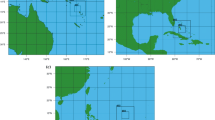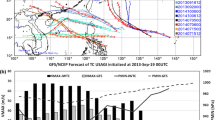Abstract
This study examines the dependence of the tropical cyclone (TC) intensity errors on the track errors in the Weather Research and Forecasting (WRF-ARW) model. By using the National Centers for Environmental Prediction global final analysis as the initial and boundary conditions for cloud-resolving simulations of TC cases that have small track errors, it is found that the 2- and 3-day intensity errors in the North Atlantic basin can be reduced to 15 and 19 % when the track errors decrease to 55 and 76 %, respectively, whereas the 1-day intensity error shows no significant reduction despite more than 30 % decrease of the 1-day track error. For the North-Western Pacific basin, the percentage of intensity reduction is somewhat similar with the 2- and 3-day intensity errors improved by about 15 and 19 %, respectively. This suggests that future improvement of the TC track forecast skill in the WRF-ARW model will be beneficial to the intensity forecast. However, the substantially smaller percentages of intensity improvement than those of the track error improvement indicate that ambient environment tends to play a less important role in determining the TC intensity as compared to other factors related to the vortex initialization or physics representations in the WRF-ARW model.




Similar content being viewed by others
Notes
The NHC official reports of the track and intensity errors can be found at: http://www.nhc.noaa.gov/verification/verify5.shtml.
In this study, a TC dynamical model is understood as a numerical forecasting model that is based on a set of the full physics primitive equations. These dynamical models are different from statistical (or statistical-dynamical) forecasting models that rely on statistical regression or empirical relationships.
Available at: http://www.aoml.noaa.gov/hrd/hurdat/Data_Storm.html.
Available at: http://www.usno.navy.mil/JTWC.
A life cycle of a TC is defined in this study as the beginning and the ending of its record in the best track dataset.
Statistical significance is evaluated by using the non-parametric hypothesis test.
Reports of numerous NCEP Hurricane WRF (HWRF) model real-time performance are available at: http://www.emc.ncep.noaa.gov/HWRF/weeklies.
References
Aberson SD, DeMaria M (1994) Verification of a nested barotropic hurricane track forecast model (VICBAR). Mon Weather Rev 122:2804–2815
Bender MA, Ross RJ, Tuleya RE, Kurihara Y (1993) Improvements in tropical cyclone track and intensity forecasts using the GFDL initialization system. Mon Weather Rev 121:2046–2061
Bender MA, Ginis I, Tuleya R, Thomas B, Marchok T (2007) The operational GFDL coupled hurricane–ocean prediction system and a summary of its performance. Mon Weather Rev 135:3965–3989
Braun SA, Tao WK (2000) Sensitivity of high-resolution simulations of Hurricane Bob (1991) to planetary boundary layer parameterizations. Mon Weather Rev 128:3941–3961
Chen YS, Yau MK (2003) Asymmetric structures in a simulated landfalling hurricane. J Atmos Sci 60:2294–2312
Davidson NE, Weber HC (2000) The BMRC high-resolution tropical cyclone prediction system: TC-LAPS. Mon Weather Rev 128:1245–1265
Davis C, Bosart LF (2002) Numerical simulations of the genesis of Hurricane Diana (1984). Part II: sensitivity of track and intensity prediction. Mon Weather Rev 130:1100–1124
DeMaria M (2010) Tropical cyclone intensity change predictability estimates using a statistical-dynamical model. In: 29th AMS conference on hurricanes and tropical meteorology, Tucson, AZ. https://ams.confex.com/ams/29Hurricanes/techprogram/paper_167916.htm
DeMaria M, Knaff JA, Sampson C (2007) Evaluation of long-term trends in tropical cyclone intensity forecasts. Meteorol Atmos Phys 97:19–28
Emanuel KA (1986) An air–sea interaction theory for tropical cyclones. Part I: steady-state maintenance. J Atmos Sci 43:585–604
Gall R, Franklin J, Marks F, Rappaport EN, Toepfer F (2012) The hurricane forecast improvement project. Bull Am Meteorol Soc. doi:10.1175/BAMS-D-12-00071.1
George JE, Gray WM (1976) Tropical cyclone motion and surrounding parameter relationships. J Appl Meteorol 15:1252–1264
Gray WM (1968) Global view of the origin of tropical disturbances and storms. Mon Weather Rev 96:669–700
Hill KA, Lackmann GM (2009) Influence of environmental humidity on tropical cyclone size. Mon Weather Rev 137:3294–3315
Holland GJ (1997) The maximum potential intensity of tropical cyclones. J Atmos Sci 54:2519–2541
Kehoe RM, Boothe MA, Elsberry RL (2007) Dynamical tropical cyclone 96- and 120-h track forecast errors in the western North Pacific. Weather Forecast 22:520–538
Kieu CQ, Zhang DL (2009) An analytical model for the rapid intensification of tropical cyclones. Q J R Meteorol Soc 135:1336–1349
Kieu CQ, Zhang DL (2010) Genesis of Tropical Storm Eugene (2005) associated with the ITCZ breakdowns. Part III: sensitivity to different initial conditions. J Atmos Sci 67:1745–1758
Kieu CQ, Truong NM, Mai HT, Ngo-Duc T (2012) Sensitivity of the track and intensity forecasts of Typhoon Megi (2010) to satellite-derived atmospheric motion vectors with the ensemble Kalman filter. J Atmos Ocean Technol 29:1794–1810
Knaff JA, Kossin JP, DeMaria M (2003) Annular hurricanes. Weather Forecast 18:204–223
Kurihara Y, Bender MA, Ross RJ (1993) An initialization scheme of hurricane models by vortex specification. Mon Weather Rev 121:2030–2045
Kwon HJ, Won SH, Suh AS, Chung HS (2002) GFDL-Type typhoon Initialization in MM5. Mon Weather Rev 130:2966–2974
Liu Y, Zhang DL, Yau MK (1997) A multiscale numerical study of Hurricane Andrew (1992). Part I: explicit simulation and verification. Mon Weather Rev 125:3073–3093
Mandal M, Mohanty UC, Sinha P, Ali MM (2007) Impact of sea surface temperature in modulating movement and intensity of tropical cyclones. Nat Hazards 41:413–427
Meng Z, Zhang F (2007) Tests of an ensemble Kalman filter for mesoscale and regional-scale data assimilation. Part II: imperfect model experiments. Mon Weather Rev 135:1403–1423
Mohanty UC, Osuri KK, Routray A, Mohapatra M, Pattanayak S (2010) Simulation of Bay of Bengal tropical cyclones with WRF model: impact of initial and boundary conditions. Mar Geod 33:294–314
Nguyen VH, Chen Y-L (2011) High-resolution initialization and simulations of typhoon morakot (2009). Mon Wea Rev 139:1463–1491. http://dx.doi.org/10.1175/2011MWR3505.1
Osuri KK, Mohanty UC, Routray A, Kulkarni MA, Mohapatra M (2011) Customization of WRF-ARW model with physical parameterization schemes for the simulation of tropical cyclones over North Indian Ocean. Nat Hazards. doi:10.1007/s11069-011-9862-0
Pattnaik S, Krishnamurti TN (2007) Impact of cloud microphysical processes on hurricane intensity, part 1: control run. Meteorol Atmos Phys 97:1–4
Shen W, Tuleya RE, Ginis I (2000) A sensitivity study of the thermodynamic environment on GFDL model hurricane intensity: implications for global warming. J Clim 13:109–121
Skamarock WC, Klemp JB, Dudhia J, Gill DO, Barker DM, Wang W, Powers JG (2005). A description of the advanced research WRF Version 2. NCAR Technical Note TN-468 + STR
Wang Y (2009) How do outer spiral rainbands affect tropical cyclone structure and intensity? J Atmos Sci 66:1250–1273
Zhan R, Wang Y, Ying M (2012) Seasonal forecasts of tropical cyclone activity over the western North Pacific: a review. Trop Cyclone Res Rev 3:307–324
Acknowledgments
We would like to thank Buck Sampson at Naval Research Laboratory-Monterey for his various valuable suggestions and corrections. We would like also to extend our thanks to the two anonymous reviewers for their very constructive comments and suggestions, which helped improve the manuscript greatly. This research was supported by the Vietnam Ministry of Science and Technology Foundation DT.NCCB-DHUD.2011-G10. The FNL data for this study are from the Research Data Archive (RDA) which is maintained by the Computational and Information Systems Laboratory (CISL) at the National Center for Atmospheric Research (NCAR).
Author information
Authors and Affiliations
Corresponding author
Additional information
Responsible editor: M. Kaplan.
Rights and permissions
About this article
Cite this article
Tien, D.D., Ngo-Duc, T., Mai, H.T. et al. A study of the connection between tropical cyclone track and intensity errors in the WRF model. Meteorol Atmos Phys 122, 55–64 (2013). https://doi.org/10.1007/s00703-013-0278-0
Received:
Accepted:
Published:
Issue Date:
DOI: https://doi.org/10.1007/s00703-013-0278-0




